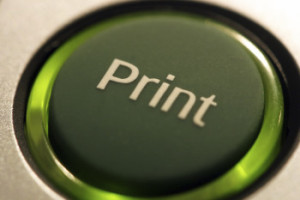Although there is no official standard to determine green printing processes, an environmentally-minded printer should utilize the most eco-friendly paper; reduce waste ink, solvents and toxic chemicals and be willing to use natural inks such as soy and other vegetable inks. There are many different types of green printing processes; the following is a list of the top 10:
- Vegetable Oil-Based Inks- The greenest types of printing processes use vegetable oil-based inks which consist of renewable resources like linseed, cottonseed, China wood oil and tung. Since these are natural elements, the waste inks can be easily recycled and reformed into new inks.
Related: Best Colors to Use in Marketing.
- Soy Inks- Similar to vegetable oil-based inks, soy inks do not contain volatile chemicals so they are gentle on the environment and can still produce high-quality and bright images. Best of all, this type of ink is recyclable and can be reused in other inks.
- Process Chlorine Free (PCF) Paper- PCF papers are those that have been bleached with only natural compounds and are 100. Although some chlorine may remain from other recycled papers, this reduction in chemicals is much easier on the environment.
- Recycled Paper- Recycled paper is best used with all printing processes to reduce the number of trees required for print runs.
- Duplex Printing- Duplex printing, printing double-sided, is an excellent method of reducing the amount of paper used during a print run. Although it may take more time to duplex print, you can save money on paper and also limit the number of trees that are being cut down to be manufactured into paper.
- Font Selection for Printing- Surprisingly, the font you select will play a significant role in the environmental sustainability of your printing process. Specific fonts require more ink than others and, therefore, cost more to manufacture. The more ink you use, the more you will need quicker and the more chemicals will be created.
- Screen Printing- Historically, the inks used in screen printing contained more solvents than other printing processes. However, more screen printers have been using UV inks which can be cured under a UV lamp. This gives the advantage of eliminating solvents from the direct printing process.
- Water-based Aqueous Printing- The most environmentally friendly type of coating during the printing process is water-based aqueous coatings. Similar to other types of coatings, these provide a protective layer and are recyclable.
- Biopolymer Printing- When printing on plastics, biopolymers are the best option as their material makeup consists of manufactured plastics that use corn and other types of vegetables.
- Digital Printing- Due to its plate-free technology, digital printing ink sits on the top layer of the substrate and creates significantly less waste. Since there are no plates, this process is fast and manufactures aesthetically-pleasing prints.
Related: 7 Tips for Highly Effective Marketing Material.
If you need help with any of your printing needs give us a call at 480-596-6300 and we can provide you with the proper consultation on green products and processes that we use here at Printing Solutions.
